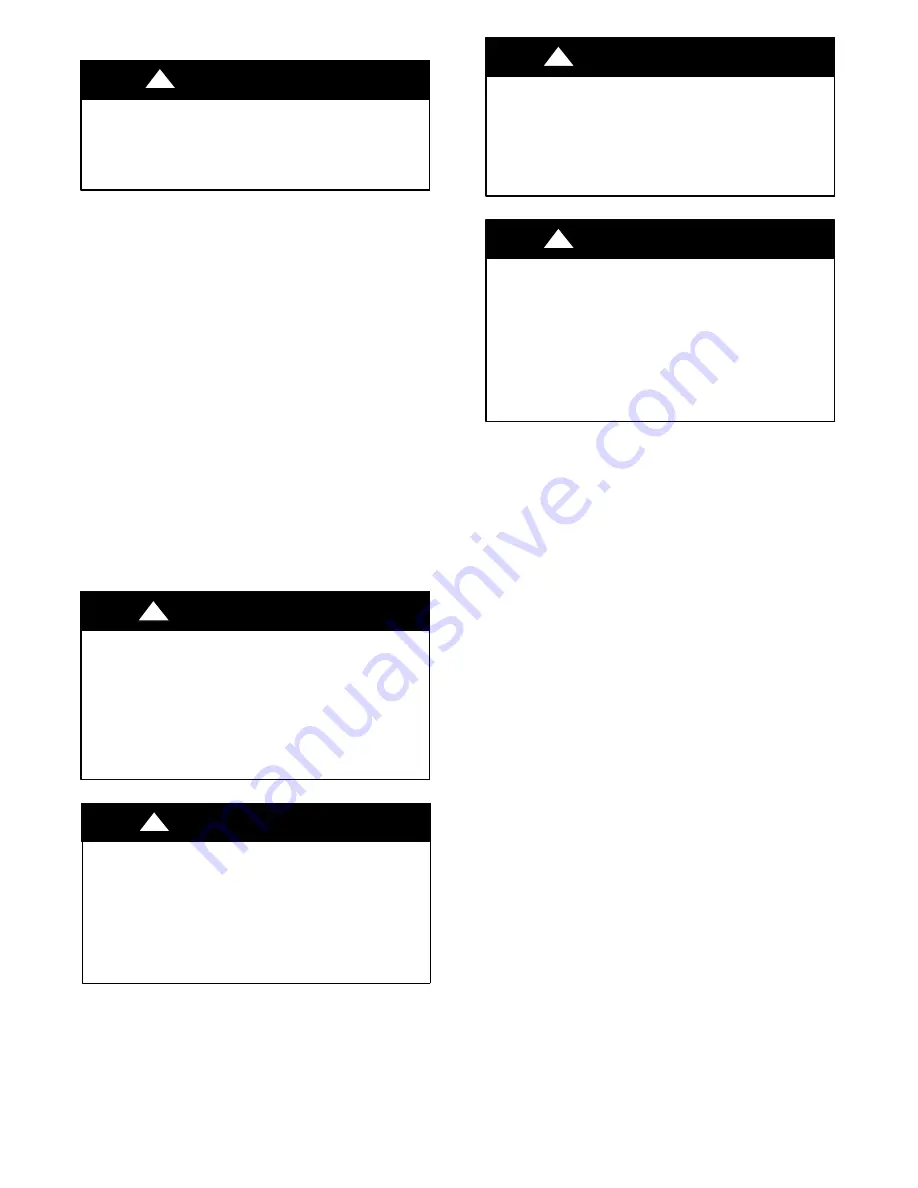
16
CHECK INLET GAS PRESSURE
UNIT DAMAGE HAZARD
Failure to follow this caution may result in unit damage.
DO NOT operate furnace more than one minute to check
inlet gas pressure, as conversion is not complete at this time.
CAUTION
!
NOTE
: This kit is to be used only when inlet gas pressure is
between 12.0--in. W.C. and 13.6--in. W.C.
1. Verify manometer is connected to inlet pressure tap on gas
valve.
2. Turn on furnace power supply.
3. Turn gas supply manual shutoff valve to ON position.
4. Turn furnace gas valve switch to ON position.
5. Jumper R--W thermostat connections on control.
6. When main burners ignite, confirm inlet gas pressure is
between 12.0--in. W.C. and 13.6--in. W.C.
7. Remove jumper across R--W thermostat connections to
terminate call for heat.
8. Turn furnace gas valve switch to OFF position.
9. Turn gas supply manual shutoff valve to OFF position.
10. Turn off furnace power supply.
11. Remove manometer.
12. Apply pipe dope sparingly to end of inlet gas pipe plug
and install into unused end of 1/8 in. tee. Use a small
back--up wrench on tee when tightening gas inlet pipe
plug.
CHECK FURNACE AND MAKE ADJUSTMENTS
FIRE AND EXPLOSION HAZARD
Failure to follow this warning could result in personal injury,
death, and/or property damage.
NEVER test for gas leaks with an open flame. Use a
commercially available soap solution made specifically for
the detection of leaks to check all connections. A fire or
explosion may result causing property damage, personal
injury or loss of life.
!
WARNING
RISQUE D’EXPLOSION ET D’INCENDIE
Cet avertissement peut entraîner de la mort, des blessures et/ou
des dégâts matériels.
Ne jamais examiner pour les fuites de gaz avec une flamme
vive. Utilisez plutôt un savon fait specifiquement pour la
détection des fuites de gaz pour verifier tous les connections.
Un incendie ou une explosion peut entrainer des dommages
matériels, des blessures ou la mort.
!
AVERTISSEMENT
FIRE, EXPLOSION, ELECTRICAL SHOCK
HAZARD
Failure to follow this warning could result in personal
injury, death or property damage.
Gas supply MUST be shut off before disconnecting
electrical power and proceeding with conversion.
!
WARNING
ELECTRICAL SHOCK, FIRE OR EXPLOSION
HAZARD
Failure to follow this warning could result in personal
injury, death or property damage.
Before installing, modifying, or servicing system, main
electrical disconnect switch must be in the OFF position and
install a lockout tag. There may be more than one
disconnect switch. Lock out and tag switch with a suitable
warning label. Verify proper operation after servicing.
!
WARNING
1. Be sure main gas and electric supplies to furnace are off.
2. Remove 1/8-in. (3 mm) pipe plug from manifold pressure
tap on downstream side of gas valve.
3. Attach manometer to manifold pressure tap on gas valve.
See Fig. 27, 28 & 29.
4. Turn gas supply manual shutoff valve to ON position.
5. Turn furnace gas valve switch to ON position.
6. Check all threaded pipe connections for gas leaks.
7. Turn on furnace power supply.
GAS INPUT RATE INFORMATION
The gas input rate for propane is the same as for natural gas. See
furnace rating plate for input rate. The input rate for propane is
determined by manifold pressure and orifice size.
The gas valve must be set for Low Heat first and then set for High
heat on 2--stage and variable--speed furnaces. Furnace gas input
rate on rating plate is for installations at altitudes up to 2000 ft.
(610 M).
In the U.S.A.
; the input rating for altitudes above 2000 ft.
(610M) must be reduced by 2 percent for each 1000 ft. (305 M)
above sea level.
In Canada
; the input rating must be derated by 5 percent for
altitudes of 2000 ft. (610 M) to 4500 ft. (1372 M) above sea
level.
The Conversion Kit Rating Plate accounts for high altitude
derate.
SET GAS INPUT RATE
1. Jumper R and W thermostat connections to call for heat.
(See Fig. 14.)
2. Check manifold orifices for gas leaks when main burners
ignite.
3. Adjust gas manifold pressure. Refer to conversion kit rat-
ing plate 339852--204, Fig. 21.
4. Turn adjusting screw counterclockwise (outwards) to de-
crease manifold pressure or clockwise (inwards) to in-
crease manifold pressure.



























